OFF THE PAGE, ON THE STAGE: POETRY AND PERFORMANCE
By Liz Hall-Downs
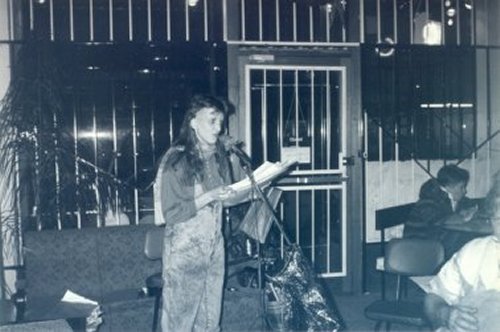
[Above] Liz Hall-Downs reading at The Lizard Lounge, Lygon Street, Carlton, Victoria, Australia (Photo by photographer unknown, c.1987)
Writers, artists, philosophers and performers have always mingled and enjoyed a cross-pollination of ideas. From the ancient Greeks, Romans and Celts through to the present day, this mingling of artists and creative thinkers from various disciplines has helped to counteract the isolation of solitary creation, and encouraged the formation of movements which have gone on to influence the wider societies in which they occurred.
The 'literary cabaret' is one of these movements, and is the model from which all modern forms of cabaret are derived. Probably the most prevalent notion of 'Cabaret' comes from the famous film of the same name starring Liza Minelli, which shows a type of singing and dancing show. In fact, cabaret also traditionally included writers and painters. 'Cabaret' comes from the French word for 'tavern' or 'wine cellar' - which have long been the venues of choice for artists to meet, discuss, eat, drink, and perform.
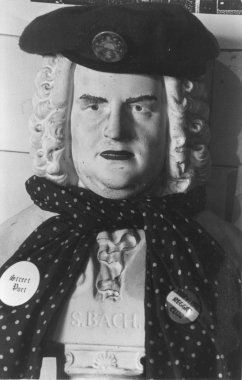
|
The first 'literary cabaret' opened in Paris, ten years after the suppression of the Paris Commune. In 1881, the Hydropathes literary society began to meet weekly in Montmartre at a venue called the Black Cat (Chat Noir), where they recited poetry, sang chanson and performed sketches and monologues. The Black Cat soon became the hub of Parisian bohemia, and its format was copied at other venues throughout the city. Its style and content spread to the east and by the outbreak of World War I there were similar cabarets operating in Berlin, Munich, Vienna and Moscow (Riley).
During the war, many pacifist and dissident artists and writers fled to Switzerland, one of the few countries to offer them refuge from death or internment. In Zurich, a group of writers and artists led by the German poets Hugo Ball and Emmy Hennings started up the Cabaret Voltaire in a seedy bar.
Cabaret Voltaire attracted a wide variety of European artists and poets, (among them Apollinaire, Kandinsky, Modigliani, Picasso, Oppenheimer, Laforgue and Rimbaud), and spawned the Dada movement. |
[Above] Cafe Jammin's Beethoven (who was also a Street Poet) (Photo by Lee Waddell, early 1980s)
The Cabaret Voltaire was closed down within a year of its opening, but its impact was far-reaching, and it became one of the most famous of the cabarets of the period. Although the movement had always been anti-bourgeois, the Dada artists who emerged from it embraced a new political radicalism that by the end of the war had so influenced the cabaret that the art produced increasingly reflected social and political, as well as aesthetic, ideals. Here's a description of the kinds of works that were presented:
[Cabaret Voltaire's] dark premises were artists' club, exhibition room, pub, and
theater, all rolled into one. The artists' performances consisted of the oddest
works which had ever before been seen or heard. Noise music, simultaneous
poems recited by 4 to 7 voices speaking all at once, bizarre dances in grotesque
masks and fancy costumes, interrupted by readings of German and French sound
verses sounding like nothing on Earth, and solemn incantations of texts by the
mystic Jacob Bohme and of Lao-Tse. (Bollinger and Verkauf).
It's not surprising that such movements were often accompanied by the conspicuous consumption of alcohol and other intoxicants (in the case of the Paris salons the drugs of choice were wine, absinthe, opium and hashish), and by a rejection of bourgeois standards of dress, appearance and morality (Salon).
In 1901 the first German cabaret, 'Colourful Theatre' was born, followed closely by Max Reinhardt's 'Sound and Smoke' and Munich's 'Eleven Executioners'. Modelled after the Black Cat of twenty years previous, it appeared as 'Kabarett', with cafe poets, dadaists and expressionists leading the charge. The juxtaposition of different artforms created a colourful, 'something-for-everyone' environment, and the Kabarett form influenced Bertolt Brecht's theory of the Epic Theatre.
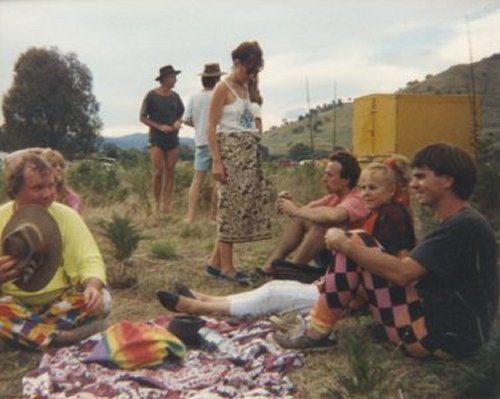
[Above] Street Poets at Down-To-Earth Confest, Walwa, from left: Thom the World Poet; Pamela 'Mimi' Sidney (obscured); Wandina (Turiya) Bruce (standing); Harry Williamson (Mother Gong); Gilli Smyth (Mother Gong); Damien Panton (Photo by Liz Hall-Downs, c.1987)
By 1933, the Nazi bonfires were blazing and countless cabaret artists, poets and satirists spent the Nazi period in exile, or worse, in concentration camps. Although cabaret continued under the Nazis, it's traditional political/satirical edge was abandoned through fear, and only innocuous entertainments and 'tits and bum shows' were allowed to be presented under the moniker - though a few brave souls, such as Werner Finck, became more political (Berghaus), and had to suffer the consequences. A rebirth of the form, with its anarchy and variety restored, occurred after World War II and has continued in Germany to the present day. The modern exposure on German commercial television has made the cabaret 'marketable' and accessible to a middle-class audience, and artists working in this field continue to challenge and criticise popular notions. But this popularization of cabaret as pure entertainment rather than art has created its own issues for creator/performers.
People are annoyed if causes and effects
are analyzed too deeply - jokes about the superficial symptoms are
enough. Throw those punchlines for all they're worth. The story, our
history, is no longer in the spotlight, but instead the performers; not their
ideas count, but rather their gimmicks. Whoever combines a good
delivery technique with stage presence and a good appearance fits into
the media world just fine and is welcome there. And that's what counts,
for this is the center of the world - even for those not very interested in
the world around them. All too often, this gives an impression of
Provincialism. (Husch and Kessler)
* * * * * *
We can see some of these influences at work, to varying degrees, in the modern Australian scene. In Melbourne in the 1980's, when I first began public readings, most poets who were being described as 'performance poets' were still using the page as a prop, and did not apply more exacting theatrical standards to themselves. But by 1990, many poets were receiving exposure on television and radio, and standards were raised organically across the board as they sought to be taken seriously by a barely poetry-literate media.
Coming on the tail end of the baby boom, my generation of young poets took as their inspiration not only the Beats, (and the other usual favourites of the young - Rimbaud, Mayakovsky, Plath, Baudelaire, etc), but also crossover, hybrid artists of the late 1970s and 1980s, such as Patti Smith, Laurie Anderson, Crass and Nick Cave, as well as embracing the influence of Leonard Cohen and Bob Dylan from our elders. These artists' niches were more rock'n'roll, punk, folk, or experimental music, but they still worked from an obvious poetic aesthetic which seemed more aligned with our own lives than the Keats, Longfellow (and even Pound and Eliot) being taught in the universities. Open readings in cafes and pubs attracted the most boisterous, anarchic, and likely-to-heckle audiences, as well as more variety in the style and quality of work presented. One of the longest-running of the Melbourne fringe venues, Cafe Jammin, welcomed anything and everything on Tuesday nights - performance poetry, 'page' poetry, soundlooping, mime and clowning, singer-songwriters, reggae bands, slides and short film - and ran on a weekly basis under the banner of 'Street Poetry' for over five years, the evenings only ending when the performers ran out of steam. There were many other, more short-lived, Street Poetry venues during this period - such as the Raglan Cafe in North Melbourne, the Outpost Inn (hosted by Ken Smeaton), the 'Butterfly and the Tiger' readings at Carringbush Library (hosted by Thom the World Poet and Carmel Bird), and Anita Sinclair's Living Room Theatre. Thom the World Poet and a stream of volunteers over many years handed out free photocopied sheets of participants' work to passers-by at places like the Bourke Street Mall, Princes Bridge and Flinders Street Railway Station.
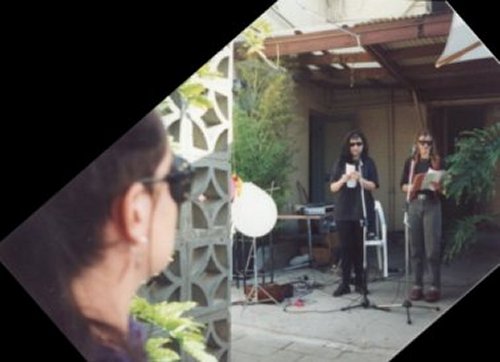
[Above] Coral Hull and Liz-Hall-Downs, Windsor Castle Hotel, St Kilda, Victoria, Australia (Photo by photographer unknown, 1991)
In my opinion, Street Poetry provided a real alternative to the pubs and the literary establishment (and given that the pub readings of the time were often frequented by sleazy, drunk, male poets who thought nothing of hassling the novice young women, this was truly a blessing). Its philosophical commitment to a community cultural development model (way before such a model became fashionable) made it inclusive rather than exclusive, its idealism attracted free thinkers, and, although a fair proportion of the work given away on the streets of Melbourne was not of a particularly high standard, it gave many novice and emerging poets a start in a supportive and non-threatening environment.
Another event with a strong Street Poetry component was the Down-To-Earth Confest, which attracted anything between five and ten thousand hippies and was held every year over the Christmas-New Year period. A large group of Street Poets would converge on this festival, held on the banks of either the Ovens or the Murray rivers, and set up a 'village' that offered twenty-four hour poetry readings to anyone who would listen. As this disorganised group's skills developed, so did the opportunities. At the 1985 Confest, I performed on the main stage to my largest audience yet - over 3,000 people.
Meanwhile, during 1984 and 1985 a group of women writers with a lesbian/feminist/multicultural bias organised the monthly Sunday afternoon 'Faceless Woman' readings at various venues on the north side of the city. Many innovative women writers who were interested in pushing the boundaries presented their work at these forums, including Bernie Janssen, Sneja Gunew, Carmel Bird, Sandra Shotlander, and Ania Walwicz. The journal, Syllable (edited by Janssen, Gunew and Bird) emerged from these readings, and also the small, cheaply produced anthology, The Writing on the Wall (compiled and edited by Bird). The latter was one of the first times the work of women poets working in the cafe and pub scenes and that of women writing within the separatist women's scenes came together.
It was launched at Shrew Women's Bookshop in Fitzroy in March 1985, and also contained work by Bird, Sue Hawthorne (later to establish Spinifex Press), Gilli Smyth (of the psychedelic 70's band, Gong), Susan Schwartz, Lauren Williams, Kerry Scuffins, Ania Walwicz and Rhonda Wilson. As a young poet with decidedly feminist leanings operating in the social 'mainstream', I found the existence of these women's groups heartening, and gained a degree of sustenance to face the often public ideological battles I found myself facing in the pubs as a result of the content of some of my poems.
The pub venues of the same period drew a slightly older crowd where the emphasis was on pure poetry (ie. musicians mostly got short shrift, being deemed well-serviced by other venues already) and the alcohol fuelled often heated debates. Weekly venues with featured readers and an open stage, such as the Rochester Castle and Provincial Hotels in Fitzroy, regularly attracted a participatory audience of fifty or more.
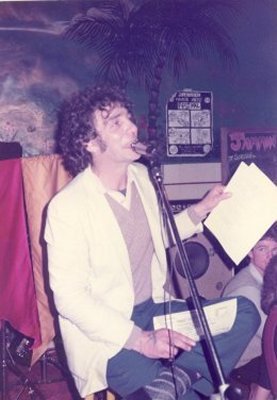
|
For a young poet like myself, these venues provided an opportunity to hear and learn from more established poets such as Eric Beach, Shelton Lea, Patrick Alexander, Cornelis Vleeskins and Mal Morgan, and out-of-towners such as Dorothy Porter, Nigel Roberts, and Billy Marshall-Stoneking. During the latter part of the 1980s the late Rex Buckingham put a lot of energy into organising these venues, booking feature readers and liasing with pub management for some kind of payment for them, and just generally trying to make the whole thing work. In the late 1980s the pub poets started publishing 'Poetry on Paper', a broadsheet that featured the work of many regular participants and sold for a dollar. The money collected went into a fund that eventually produced the more permanent anthologies Poems from the Rochester Castle and Poems from the Provincial Hotel. Geoffrey Eggleston, and later Mal Morgan, Myron Lysenko and others, coordinated the yearly Montsalvat Poetry Festival throughout this period, a summer gathering of poets at the Eltham artists' colony that still continues today. |
[Above] Shelton Lea at Cafe Jammin (Photo by photographer unknown, early-mid 1980s)
The content and quality of the Montsalvat festivals have varied according to the particular organisers, the available funding, and the state of inter-poet politics at any given time. Stories abound of poets in the past having punchups, affairs, shouting matches, ideological battles, and too much (or not enough) alcohol or drugs at Montsalvat. But I also recall Montsalvat festivals that were friendly, inspiring, well-organised, and inclusive, though of course these occasions didn't make for such delicious gossip. Regardless, even in the face of occasional anarchy, the festival at Montsalvat has always provided a venue for a large number of poets to get together, share work and socialise, and has become something of an institution that transcends the biases of the various groups meeting throughout the year.
For the more conservative set, the Melbourne Poets Union met monthly in a church hall in Clifton Hill. These readings formed the basis of what became the Pariah Press Collective, who went on to publish poetry volumes by many of their members, including Rosemary Nissen, Joyce Lee, Kristin Henry, Barbara Giles, Ken Smeaton and Catherine Bateson.
Venues with an entry fee, such as the monthly 'Poetica' at La Mama, (run for many years by the late Mal Morgan, then Catherine Bateson and, recently, Lauren Williams) drew their readers from all of these forums and presented contemporary poets and prose writers to a wider, literary audience, in a theatre setting.
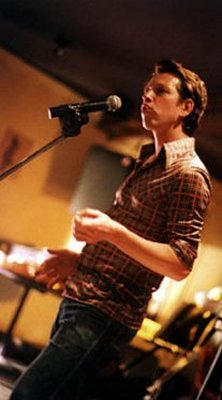
|
It's worth remembering that these groups were not mutually exclusive, that there was a lot of crossover, with poets going to some or all of the venues, depending on their need to read and listen and their liking or otherwise of the venues and the crowds they attracted. And we all had different reasons for taking to the poetry stage in the first place.
In my case, I was attempting to regain some self-esteem in the face of being recently diagnosed with a painful, chronic and lifelong physical condition, a situation that put an end to any ideas I might have had about 'career'.
Poetry became a lifeline, a way of interacting with a world from which I was feeling increasingly excluded and alienated. At the venues, at least people listened and judged a person on the strength of their words, not their usefulness to the economy.
Through the venues, the aspiring poet could meet and mingle with dozens of more established poets and be exposed to an amazing variety of approaches to the art of writing poetry. I remember clearly the very first time I stepped up to the microphone. It was Cafe Jammin, mid to late 1983, I was twenty-two years old, and I was terrified. |
[Above] Photo of Terry Jaensch by Stephen Booth, 2001.
It's the only time, before or since, that I've physically experienced the phenomenon of my 'knees turning to jelly', but regardless I haltingly made it through three or four poems and was stunned by the enthusiastic applause that is reserved for 'virgin' poets. I became a regular reader at the cafe, and found a friendly group of peers who saw me as someone with promise who could write a passable poem, instead of a malingerer or a disability on legs. I can't overstress how important this was to me at that time.
In the past decade, the home computer has put desktop publishing, sound recording and mixing, CD burning, and self-promotion within the reach (or at least in the consciousness) of most artists on the fringe. Paid gigs as a performance poet have become valid resume-fillers for grant applications, and self-publishing has shed much of its negative image. (Notably, the Ann Elder award for a first book of poetry now accepts self-published titles.)
Orality has returned to favour, as bush poets tour the country, form their own associations and release their work on CD; as contemporary poets experiment with hybrids of text, sound, vision and the spoken word, and invade music venues; as literary magazines and individuals explore the possibilities of cyberspace; and as writers of all persuasions appear in the flesh at literary festivals to meet and greet the public.
All of this is great for writers and readers, but it's worth being aware of the pitfalls. Especially in the Poetry Slam movement, the American experience is that the arrival of spoken word on MTV has raised performance standards but has also raised the stakes. Writers can sometimes find themselves caught up in aggressive competition that serves an audience's desire to see blood on the floor but does little to enhance the writing community's cohesion, and can shift individuals' focus from producing innovative work to being a kind of human joke machine or jukebox in the (I feel, misguided) belief that poetry might actually pay in the long-term. When I toured the American midwest in 1994, I was struck by the strong aura of dog-eat-dog competitiveness that seemed to emerge out of nowhere when MTV for the first time offered serious money and exposure to whoever won the National Slam. In this kind of climate I feel it's very important for poets to remember that we're all practitioners of a marginalised artform that will stay that way if we can't rise above our differences and work together, and avoid treating 'competitions' as anything more than the game they are. When approached in this spirit, a poetry Slam can provide serious fun.
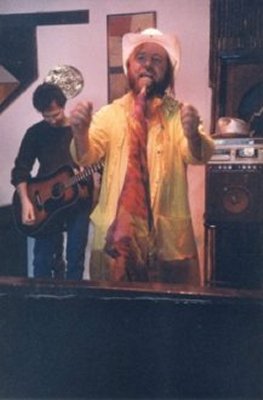
|
When I moved to the Byron Bay region in the early 1990s, I noticed regular poetry venue organisers were refusing to give feature readings to several writers of quality because they either weren't performers or weren't 'funny'. And it occurred to me that the problem with many performance poets (and this seems to be truer of poets in the regions than the cities) was that they didn't read contemporary poetry (or indeed read at all), and that their sensibilities came either from rock and roll, comedy, or the bush poetry tradition. Performance skills in all of these forms are mandatory, but it's arguable that in many cases 'the baby gets thrown out with the bathwater', and the quality of the actual writing becomes secondary.
The whole phenomenon of 'performance poetry' was discussed recently in the 'Weekend Australian' as if the two camps ('performance' and 'page' poets) were mutually exclusive, and somehow at loggerheads. If this is the case, I'd argue that it's a fairly recent development, and derives from the difficulties presented by venue organisers like the ones I've described above. |
[Above] Thom the World Poet backed by Clint Small (Photo by photographer unknown, year unknown)
My own experience in Melbourne back in the 1980s was that people who could simply read well from the printed page were starting to be referred to as 'performance poets', and that most of these poets were also publishing in tandem.
For myself, probably ten percent of my output as a poet could be described as 'performance' (in the way the term is being bandied about nowadays, that is, declamatory and paper-less), and that these types of poems were an essential part of any poet's repertoire, to be drawn on on those occasions when the audience was drunk, uninterested, or both.
There have been many, many occasions, especially in my days of presenting poetry in between band sets in the punk years, when the strident, declamatory 'Bitchpoem' (published and republished in several of my collections), and others like it, has quite literally saved me from being pelted with beer cans. But, as Billy Marshall Stoneking commented in the abovementioned article,
the two forms should not be in conflict because a great page poem is a great oral
poem. "You can't make something sound better than it really is.
All you can do is find its voice." (Powell 5)
In the same article, Elizabeth Webby blames the modernists (Eliot and Pound) for the complexity of much modern poetry, remarking that previously devices such as rhyme were generally used because of the form's essential orality. She remarks that:
It seems to be a bit of a false debate … There are good and bad performance
poets, and good and bad poets. But it's true there's a bit of prejudice about it. (8)
All of this, for me, begs the question: just because I can perform, does this mean I should? Or perhaps there's more respect to be gained by sticking to publishing. After all, in the performance world, one is only as good as their last gig. But in these increasingly technological days, and at a time when publishing houses are abandoning poetry in droves, oral presentation still seems to be one of the best ways for poets to gain audiences and sell books. I believe this should never, however, be at the expense of good writing on the printed page. If poets allow themselves to be seduced too much by the instant gratification of audience approval, instead of seeing public readings as a marketing tool, I fear that poets as we've known them will disappear from public life, to be replaced by whoever is the funniest, the most attractive, or the best actor. Given that a writing life is a long one, and that most of us will produce our best work with the benefit of years of writing and life experience behind us, this would indeed be a tragedy for poets and for poetry.
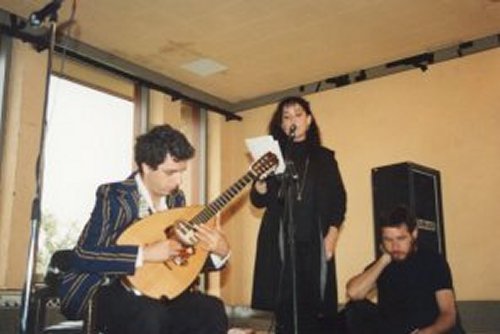
[Above] Joseph Zammit, Coral Hull and Geoff Fox, Eltham Hotel, Victoria, Australia (Photo by Dennis Woodley, 1993)
WORKS CONSULTED:
Berghaus, Gunter, "Oppositional Cabaret in Nazi Germany, or: Walking a Political Tightrope Over the Abyss", Shine, Issue 12 (Theatre Theory), January 2000
(http://www.blesok.com.mk/blesok12/gb2.html)
Bollinger, Hans and Verkauf, Willy, "Cabaret Voltaire", from Dada Dictionary, Dada: Monograph of a Movement
(http://www.peak.prg/~dadaist/English/Graphics/cabaret_voltaire.htm)
Husch, Hanna Dieter and Kessler, Jurgen, "100 Years of Cabaret in Germany", (trans. Alan Lareau, Feb 2000)
(http://www.kabarett.com/7_Basic/Basic.html)
Powell, Sian. "Stand and Deliver." Weekend Australian. 28 Aug. 2001: Review: 28
Riley, Dave, "Cabaret: When Voltaire met the Black Cat"
(http://jinx.sistm.unsw.edu.au/~greenlft/1993/89/89p24.htm)
Unnamed author, "A Brief History of Salons", Salon Magazine (www.salon.com), San Francisco, CA.
(http://www.salon1999.com/07/bookfront/history2.html)
A shorter version of this article previously appeared as "Off the Page, On the Stage: Literary Cabaret, its Origins and Traditions" in Writing Queensland, August, 2001.
This article was a joint winner of the 2001 AEE Pearse Prize for a postgraduate essay published in a refereed journal administered by the English department at the University of Queensland.
About the Writer Liz Hall-Downs
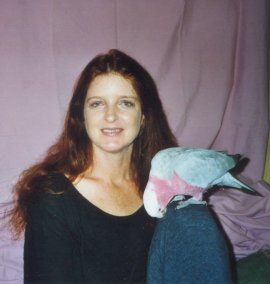
|
Liz Hall-Downs has been reading and performing poetry in public, on TV and radio in Australia and the USA, and publishing in journals, since 1983. Liz holds a BA from Deakin University (Victoria) with major studies in Professional Writing & Literature. Some of her books include; People of the Wetlands, historical writing commissioned by Brisbane City Council, 1996, Fit of Passion, by Liz Hall-Downs & Kim Downs, (Fit of Passion Collective, 1997), Mountains to Mangroves, and Mountains to Mangroves Haiku Cycle, A collection of Historical/ Environmental writing commissioned by Brisbane City Council and Queensland Wildlife Preservation Society, 1999, Blackfellas Whitefellas Wetlands, Poetry & Music from the Boondall Wetlands by Liz Hall-Downs, B.R. Dionysius, and Samuel Wagan Watson, (Brisbane City Council & Boondall Wetlands Management Committee, 2000) and Girl With Green Hair, (Papyrus Publishing, 2000). |
[Above] Photo of Liz Hall-Downs and Alice by Kim Downs, 2001.
I Next I
Back I
Exit I
Thylazine No.5 (March, 2002) |



